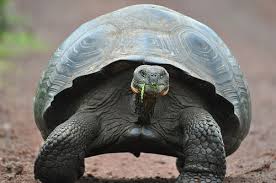The Galapagos tortoise (Chelonoidis nigra) is the world’s largest tortoise species. It is also called Galapagos giant tortoise. The tortoise is typically found in the Indian Ocean and Galapagos west of Ecuador. Giant Galapagos tortoises are mainly recognized by their large bony carapaces which are brown in color.
Galapagos Tortoise Facts
Anatomy
- The Galapagos tortoise is distinguished from other tortoises by its large brownish shell. It can contract its limbs and neck into the shell when the tortoise senses danger.
- Males are larger than females. Adult males weigh 272–317 kg (600–699 lb) while females average 136–181 kg (300–399 lb) in weight.
- The mean length of the carapace is about 51 in (130 cm). The carapace has different colors and shapes ranging from black to dark brown and rounded, saddled to dome shaped.
- The Galapagos tortoise has long neck and small head.
- There are scales on the tortoise’s legs and these scales protect the animal.
- They live on one of the driest parts of Ecuador islands but they do travel toward volcanic highlands which are abundant in vegetation and water.
- Males have longer tails as compared to those possessed by females.

Range & Habitat
- Galapagos tortoises are likely to be found only in the Galapagos Islands off Ecuador. They are thought to make homes in humid highlands including volcanic islands to the wet uplands.
Behavior
- The Galapagos tortoise’s foraging time is 8 – 9 hours per day. It comes out minutes after the sunrise to bask in the sun. Tortoises bask for about 1 – 2 hours.
- They are thought to travel in morning or in the late afternoon.
- Galapagos tortoises walk at a speed of 0.3 km/h (0.2 mph).
- Tortoises living on the humid islands will migrate between the low grass plains and high elevations of 2,000 ft (610 m).
- They will sleep in shelters or under vegetation at night. Tortoises remain active all day long.
- Unlike females males are slightly vocal.
Feeding Ecology & Diet
- The Galapagos tortoise is an herbivorous animal. It consumes leaves, berries, succulents, cacti, leaves of bushes, and lichens.
- Plants make up the essential part of the tortoise’s diet. It includes the water fern, bromeliad, and poison apple.
- Young tortoises eat 16.7% of the body weight each day.
- Adults take moisture from dew vegetation such as Opuntia
- The Galapagos tortoise is capable to survive 180 days without water.
- Tortoises don’t seem to hear a human walking near around them. They are almost if not absolutely deaf.

Reproductive Biology
- The peak mating season ranges from February to June but generally they mate anytime during the year. In some islands the mating begins in December and ends on August.
- Females travel kilometers to get to the breeding sites which are dry sandy coasts. They will dig nests as deep as 7–12 in (18–30 cm) and it may take several days to complete.
- The clutch size averages 16 eggs with the mass measuring up to 82 to 157 grams (2.9 to 5.5 oz) and diameter of 2.2–2.6 in (56–65 mm). The tortoise’s eggs are almost the size of a billiard ball.
- Young tortoises leave the nest at 4 – 8 months of age. They are 6 cm (2.4 in) long and weigh only 50 g (1.8 oz).
- The incubation period ranges from 85 – 200 days.
- When the young come out of their hard-shelled eggs they must find a way (on their own) to get to the surface. Their journey from shells to the surface could last several days. Nonetheless young tortoises can remain in a yolk sac for as long as 210 days. The soil must be wet and soft enough so that newborn tortoises could dig to the surface. If it is hardened then they all die underground.
- One can only distinguish between male and female tortoise once they reach 15 years of age.
- Galapagos tortoises attain the maturity at 40 years of age in the wild. However in captivity they become mature as early as 20 – 25 years age.
- The average life expectancy in the wild is about 100 years. The oldest specimen died at the age of 170 years in an Australian Zoo.
Conservation Status
Vulnerable






Leave a Reply